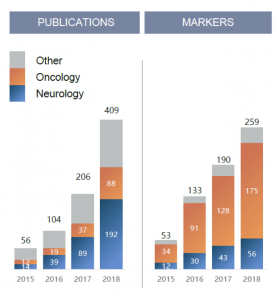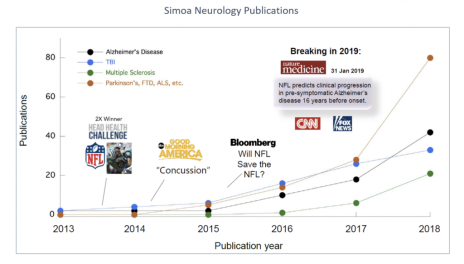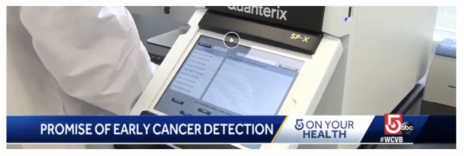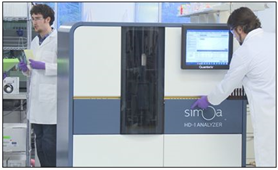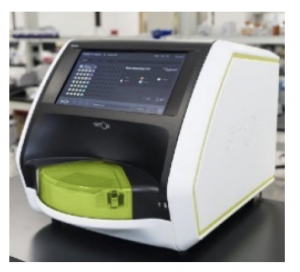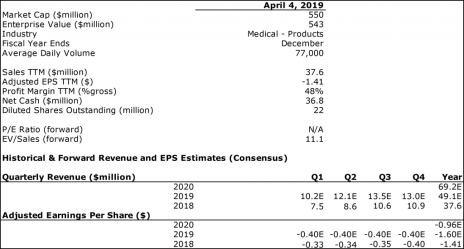This month we’re wading deeper into the MedTech space with a life sciences company that’s commercializing a disruptive technology that could diagnose disease in seemingly healthy people.
It’s an exciting story of a young company that appears to be in the early innings of its growth curve, but has made it far enough with respect to technology development, customers and strategic partnerships to attract attention from larger investors.
Revenue was up 60% in 2018, and is projected to keep growing at a rapid rate. All the details are inside this month’s Issue.
Cabot Small Cap Confidential 239
[premium_html_toc post_id="174524"]
THE BIG IDEA
What if your doctor had a simple blood test that could predict Alzheimer’s Disease 15 years before any symptoms begin? Would you take it?
How about a test that could predict the likelihood of getting Parkinson’s Disease, multiple sclerosis, and dementia?
Let’s say Dr. Miracle offered up a blood test that detected cancer way earlier in disease progression than any other diagnostic test on the market today. Then what?
I suspect you’d jump at the opportunity to fight these diseases—if you had them—as early as possible and increase your chances of a long and happy life.
This isn’t some fantasy blood test devoid of scientific basis or technological capability. The technology to perform it is being used right now by researchers around the world, and by 23 of the top 25 biopharmaceutical companies.
It’s called Simoa, short for Single Molecule Array.
It allows the detection and quantification of protein biomarkers that have been difficult or impossible to measure in serum, plasma (blood), cerebrospinal fluid (CSF), urine and cell extracts.
Simoa technology can detect thousands of single protein molecules simultaneously, making it 1,000 times more sensitive than previously used protein analysis methods. And more researchers are taking note every day.
In 2016, there were 104 scientific publications focused on Simoa. The number of publications nearly doubled, to 206, in 2017. Then it almost doubled again in 2018, to 409.
The findings in these publications have been impressive, leading to tons of media coverage, public awareness and FDA support since there are huge unmet needs in life science research, biopharma and in-vitro diagnostics.
For example, five million people in the U.S. visit the ER every year with Traumatic Brain Injuries (TBI). Many get a general diagnosis, at best. Even a CT scan fails to diagnose 90% of mild TBI. The same goes for diagnosing concussions and chronic traumatic encephalopathy (CTE), the latter of which can only be confirmed after death with a brain autopsy.
Neurology researchers believe Simoa can diagnose these conditions by identifying relevant neurological biomarkers, including Nf-L, tau, GFAP and UCHL-1.
In January 2019 researchers using Simoa technology found that a simple blood test for the neurological biomarker Nf-L could detect Alzheimer’s disease up to 16 years before symptoms begin. Their findings were published in Nature Medicine.
The same general concepts can be applied to early cancer detection, and to studying the effectiveness of cancer drugs in the body as they fight the disease.
You may be thinking Simoa technology sounds an awful lot like DNA sequencing. It’s in the same general family, but protein analysis is very different from DNA analysis, in very important ways.
Consider the example of identical twins. They share the exact same DNA, but they usually develop as very different people, suffer different illnesses, and die from different causes? Why?
Genetic analysis can help indicate the risk of a person developing a certain disease later in life. But protein analysis can help show what diseases a person is at risk of developing before symptoms even occur and/or early in disease progression.
That’s because genetic analysis can’t factor in environmental factors and lifestyle choices.
If somebody sits on the couch, drinking beer, smoking cigarettes, eating pizza and watching TV all week, DNA analysis isn’t going to say much about what diseases he or she is at risk of getting for making those choices.
DNA analysis also won’t tell the person who exercises daily, eats a balanced diet with lots of fruits and vegetables, drinks in moderation, avoids the sun, does Yoga, and brushes their teeth regularly if any diseases are developing in their body.
To understand what is happening with a person’s health right now, in real time, you need to study their proteins.
Simoa technology has the potential to shift the paradigm of healthcare from invasive tests and treatments late in disease progression to non-invasive tests and treatment methods done much earlier, even before signs of disease show up.
Eventually, it could even be used to screen seemingly healthy people as part of their regular physical exams, opening the door to preventative treatments and lifestyle choices that could ward off neurological diseases, cancer, cardiovascular disease and infectious diseases.
Simoa technology is a proprietary platform developed by the small-cap company I’m profiling today. It’s an exciting story that’s still in its early days, so there are risks. But it has immense potential to reward patients and investors alike over the coming decades.
THE COMPANY
Quanterix (QTRX) is commercializing a disruptive protein analysis technology that has the potential to detect disease in seemingly healthy, asymptomatic people, with simple blood draws taken as part of routine health screening.
The industry term for this emerging field is proteomics. It encompasses both genomic and protein research. Just like the sequencing of the human genome advanced our understanding of the human body, proteomics has the potential to change the game with respect to diagnosing, treating and even preventing disease and injury.
The company’s key asset is its next-generation, ultra-sensitive digital immunoassay platform, which is based on a proprietary Simoa bead-based detection technology. This technology allows customers to reliably detect protein biomarkers in extremely low concentrations in blood, serum and other fluids with sensitivity 1,000-times more powerful than other options on the market.
The analysis is relatively easy, with the right equipment. To perform a test a lab tech preps blood samples with a special antibody wash, then places them inside one of Quanterix’s proprietary machines. The wash binds to the specific protein bio-markers in the blood, illuminating them to be captured by ultra-sensitive cameras in the machine.
Armed with insights into the role of protein biomarkers in human health, Quanterix’s customers – which are almost equally split between academia and biotech/pharma – are working to develop novel therapies and diagnostics and shift the healthcare focus from late diagnosis and treatment to early detection, monitoring and prevention.
Quanterix went public in December 2017 at $15 a share. It is based in Lexington, Massachusetts, grew revenue by 60% in 2018, and has a market cap of $520 million.
To date, it’s been going after the life sciences research market because there is no reimbursement risk and a ton of demand from academic, biotech and pharma companies. Management believes life sciences research represents a $3 billion market opportunity today, growing to $8 billion over the next few years.
Quanterix has already made significant progress. It has over 420 customers and 23 of the 25 largest biopharmaceutical companies, including Merck, Pfizer, Biogen, Genentech, Sanofi, Takeda and the National Institutes of Health.
The diagnostics/companion diagnostics market represents the next leg of growth for Quanterix, and it could be a big one given the market potential is around $30 billion a year.
With Simoa, an entirely new category of non-invasive diagnostic tests could be developed to stratify patients into categories for clinical trials and treatment. Even healthy people could be precision screened before symptoms appear, and those results can be compared to baseline measurements to help predict or detect the early onset of disease.
There are risks to the diagnostic and precision health markets too, including regulatory approvals and reimbursement risk once tests are being used on people. But these risks are worth taking on, and management is devising its plan to enter the market. The strategy will likely involve partners and is something we’re sure to talk a lot about as this story progresses.
A Rising Wave of Scientific Publications Driving Interest in Quanterix
A big driver of interest in Quanterix is coming from scientific research publications. As the number of publications featuring Simoa technology has grown (nearly doubling to 409 in 2018), especially in neurology and oncology, so too has the number of Simoa biomarker assays designed for each application. This is driving sales of instruments and consumables.
Last year Quanterix derived 69% of revenue from neurology and 23% from oncology. The “other” categories Quanterix is starting to establish footholds in include infectious disease (7% of revenue last year), cardiology (1% of revenue in 2018) and inflammation.
Let’s talk a little about what’s going on in each application.
Neurology
The brain is the only organ in the body for which there is no blood-based diagnostic test. The blood-brain barrier is just too tight to allow movement of proteins (and other substances) through the endothelial cells lining the cerebral microvasculature into the blood stream. That’s why diagnosing brain disease and injury requires either an MRI or a spinal tap to collect cerebrospinal fluid (CSF).
These are expensive and invasive options.
Simoa can change this. The technology can detect ultra-small levels of critical neurological biomarkers that diffuse through the blood-brain barrier and are released into the blood during injury, and with the onset of many neurodegenerative brain diseases. These include Alzheimer’s disease, Parkinson’s disease, dementia, multiple sclerosis, concussion/traumatic brain injury (TBI) and chronic traumatic encephalopathy (CTE).
Because of Simoa’s potential, Quanterix has won two grants from the National Football League (NFL) – General Electric (GE) Head Health Challenge to develop the technology to detect mild TBI.
One of the big studies was in 2017, when researchers using Simoa technology on 600 patients from the Alzheimer’s Disease Neuroimaging Initiative found that a simple blood test for the neurological biomarker Neurofilament light (Nf-L) had similar diagnostic accuracy (approaching 90%) as currently established CSF biomarkers for diagnosing Alzheimer’s disease.
Since then the publication spigot has been open. Then in January 2019 the journal Nature Medicine published a study saying a blood test measuring Nf-L could detect Alzheimer’s up to 16 years before symptoms begin. Quanterix’s Simoa technology was used in the study.
The slide below is from a recent investor conference. You can see the growth trend in publications covering Simoa in neurology (176 publications in 2018). All this interest is having a direct positive impact on sales of Quanterix instruments for neurology, which have grown at an average annual pace of 67% since 2015. Neurology represents a big market, estimated at around $6 billion a year.
Oncology
If neurology is the big fish, oncology is the whale. Management estimates that Simoa could address a potential $25 billion market in oncology as the technology is developed.
That’s because Simoa has the potential to help detect, diagnose, treat and even predict many forms of cancer. As in other applications, the idea is to detect increased levels of cancer biomarkers in the early stages of disease development with a simple blood-based health screen. This screen could be used as an alternative to routine mammograms and to detect lung and pancreatic cancer, potentially reducing the need for invasive and expensive imaging and biopsies.
Simoa can also be applied to the field of immune-oncology to help put patients into groups based on predicted responses to treatments, risk of recurrence and adverse effects. Already, Quanterix has developed a set of 38 ultra-sensitive immune modulation assays that can be used to monitor the immune response to cancer drugs. And it has developed a biomarker assay for Prostate Specific Antigen (PSA) – the only one of its kind – that has been used by researchers from John Hopkins and NYU to predict recurrence of prostate cancer following radical prostatectomy.
Scientific publications discussing Simoa’s use in oncology are on the rise, up from 37 in 2017 to 88 in 2019. They helped oncology-related revenue jump 110% last year and grow to represent 23% of total revenue.
Infectious Disease
The secret to controlling the spread of contagious viruses is to catch them early before they have the chance to multiply. To provide just one example, Quanterix has developed a simple Simoa assay for detecting the HIV-specific antigen, p24, that is over 4,000-times more sensitive than the benchmark commercial protein assay. This assay can yield a test result a week faster too.
Cardiology
Cardiovascular diseases account for nearly a quarter of all deaths in the U.S., making it one of the clear leaders in curbing population growth in this country. Simoa has the potential to change the trend by helping to predict heart attacks and other cardiac events before they occur.
Inflammation
Simoa can help give a better idea of a person’s immune response and disease progression by measuring low levels of inflammatory proteins present in a wide range of diseases, such as asthma, Crohn’s disease, rheumatoid arthritis and neuro-inflammation. It can also be used by companies developing anti-inflammatory drugs to quantify the effect a drug has on inflammatory proteins, including cytokines and chemokines.
A Crash Course in Proteomic Research and ELISA vs. Simoa Technology
Proteins are complex molecules that organisms need for the structure, function and regulation of tissues and organs. They serve a critical function in just about every biological process. They help us move, transmit nerve impulses, control cell growth and differentiation, and provide immune protection.
Genes, which are comprised of DNA, have as one of their primary jobs the task of regulating protein production. Based on both biological and environmental factors, genes decide which proteins to produce, in what quantity, and for how long. There are 20,000 genes in the body, and they help govern the expression of roughly 100,000 proteins.
The proteome is the entire set of proteins expressed by a genome, cell, tissue or organism at a certain time, under certain conditions. Proteomics is the study of the proteome, and it provides a much more powerful window into a person’s overall health than genomic research alone.
Roughly 10,500 of the proteins in humans are known to be secreted in blood. Conventional immunoassay technologies consistently detect only about 1,300 of them in healthy people. That leaves around 9,200 that are not consistently detected. This lack of sensitivity has greatly limited study of much of the proteome.
Enzyme-Linked Immunosorbent Assay (ELISA)
For over four decades ELISA has been the most widely used method of protein detection. It is frequently done as a blood test to detect antigens (harmful substances like viruses, parasites and bacteria) that may be present in the blood.
The most common variation of the ELISA test is done in a 96-well polystyrene plate, which contains the specific antigen (pre-affixed to the plate well) for which the patient is being tested. A detection antibody – for instance, purified human chorionic gonadotropin hormone (HCG), a protein that indicates pregnancy – is linked to an enzyme and mixed with a blood sample, then added to the test system.
In the pregnancy example, if the test is negative only the linked enzyme will bind to the antigen. If positive, the linked enzyme will not bind but the antibody (i.e. the HCG in the pregnancy example) will. Dye or fluorescent product molecules are used to cause a color change reaction, so the lab technician knows if the test is positive or negative, or somewhere in between.
Simoa Technology
Quanterix’s Simoa bead-based digital immunoassays operate on the same basic principles of ELISA. But instead of running the enzyme-substrate reaction on all molecules in the comparatively large wells of a polystyrene plate, Simoa reactions are run in tiny microwells that are 2.5 billion-times smaller than traditional ELISA wells.
Over 200,000 microwells, each of which holds one bead, can be contained in one Simoa disc. This disc is then loaded into a Quanterix instrument, which reads the array and gives the results.
The following image shows how it works.
The bottom line is that Simoa yields incredible protein detection sensitivity and yields either a positive or negative result, not a range of possible results that are entirely dependent on sample concentration, as is the case with traditional ELISA.
Quanterix has committed to releasing the fourth generation of its products by 2021, which it says will be 100 times more sensitive than those it sells today.
Simoa Planar Array Technology
As part of its push into oncology, Quanterix has been developing a Simoa planar array technology. This technology operates on the same basic principles of conventional sandwich ELISA but concentrates the signal to a surface area 1,000 times smaller. The result is a much more sensitive test for researchers who want to measure immunomodulatory biomarkers in patient serum and plasma in a multiplex assay format.
THE PRODUCT
Quanterix has three revenue sources: instruments, assay kits and other consumables and contract research services.
Instruments
Quanterix’s first solution, the HD-1, is a fully-automated floor-standing instrument that was launched in 2014 for running immunoassays in many therapeutic areas using the Simoa bead platform. Users load samples into the sample bay, reagents into the reagent bay, then select the desired assay from the touchscreen.
Results start coming 30 minutes later and can be viewed on the screen or exported to specialized software. The HD-1 can run up to 500 samples per eight-hour shift. Its ease of use and high throughput has helped the HD-1 become the most widely referenced ultra-sensitive multiplex immunoassay platform on the market. Quanterix expects to commercially launch the next generation of this technology, the HD-X, in the second half of 2019.
The smaller brother to the HD-1 is the SR-X, which was launched in late 2017. This benchtop unit uses the same Simoa bead-based technology as the bigger HD-1 but without all the automation capabilities and bells and whistles. It comes at a far lower cost too.
Quanterix’s newest instrument the SP-X, looks and operates a lot like the SR-X but uses a Simoa planar array technology that the company refined after acquiring Aushon Biosystems in early 2018. The SR-X is designed for cancer and was released via soft launch in January, with a full launch scheduled for the second quarter of 2019 (i.e. any day now).
Assay Kits & Other Consumables
Quanterix sells a variety of consumables that are used to run assays on its instruments, including Simoa disks, cuvettes, disposable tips, and assay-specific reagent kits. It has almost 260 assays (new ones are being added all the time) and sells a bead-based Homebrew Assay Development Kit that allows customers to develop their own assays.
Contract Research Services
Quanterix’s Accelerator Laboratory has a CLIA-certified lab and provides customers with contract research options where researchers, academics and principal investigators can work with company scientists to test specimens, develop prototypes assays and fine-tune new assays. The company has worked with around 180 customers from around the world on over 520 projects, and the Accelerator Laboratory has helped sell approximately 45 instruments to these customers.
The Business Model
Quanterix sells instruments, consumables and services to life science, pharmaceutical, biotechnology and diagnostics industries. The company has a razor-razorblade business model. It sells high-priced instruments that are relatively low profit items, then sells a constant supply of much lower-priced consumables that are relatively high-profit items. Management’s target is to generate around one-third of the cost of an instrument in annual consumable sales (called annual utilization).
Instruments are manufactured by Germany-based STRATEC Biomedical (HD-1, HD-X), California-based Paramit Corporation (SR-X) and Quanterix’s Billerica, MA facility (SP-X). Consumables are made at Quanterix’s Lexington, MA and Billerica, MA facilities, sourced from STRATEC Biomedical, or sourced from a limited number of other suppliers.
In North America and Europe Quanterix sells through a direct sales force, and it uses distributors and sales agents in other areas of the world. The current customer base is academic and government research institutions, pharmaceutical and biotech firms and contract research organizations (CROs).
The Bottom Line
Quanterix grew 2018 revenue by 65%, to $37.6 million. The revenue mix was 25% instruments (up 45%), 37% consumables (up 83%) and 32% services (up 58%). The remaining 6% was collaboration revenue related to the termination of a licensing agreement with BioMérieux. Excluding that one-time adjustment—the better way to look at the business—takes revenue growth down slightly, to 60%. Gross margin (excluding one-time) was 46%, up from 44%. Adjusted EPS loss in 2018 was -$1.41. Annual utilization was 40%.
In Q4 2018, revenue was up 65% to $10.9 million. The revenue mix was 33% instruments (up 106%), 36% consumables (up 67%) and 31% services (up 52%). Gross margin was 48%, up from 44% in Q4 2017. Gross margins are being helped by a greater mix of high margin consumables (a trend that should continue) and greater economies of scale as Quanterix grows. Adjusted EPS loss in Q4 was -$0.40.
Looking forward, management believes there is a lot more room to expand gross margins as Quanterix gains leverage in the business and consumable sales keep ramping up. That said, the company is pouring money into sales and marketing people as well as external strategic marketing initiatives. It will also be paying higher salaries for new senior management personnel, a new headquarters, and to develop a strategy for entrance into the diagnostic space, which could include acquisitions. In terms of cash, the company ended 2018 with $45 million in cash and 22.4 million shares outstanding. It has $7.6 million in debt.
Consensus estimates point toward revenue growth of 30% in 2019 (EPS of -$1.60) and 40% in 2020 (EPS of -$0.96).
RISK
Simoa Technology Becomes Obsolete: The biggest risk is that Simoa fails to live up to expectations or is leapfrogged by a competing protein analysis technology. It appears to have a leading position today, but things change. Quanterix will need to keep developing new instruments and assays to keep ahead of the pack.
Lumpy Instrument Sales: Quanterix’s instruments are big ticket items and purchases often require lengthy review processes by potential customers. This can lead to lumpy sales patterns. Sales of consumables should fill in the gaps, but investors still shouldn’t expect the type of smooth revenue growth that often comes with other types of companies (such as software developers).
Expansion in to Diagnostics: Management’s plans to move into diagnostics means Quanterix becomes exposed to reimbursement risk and regulatory risk (clinical trials, FDA approval, etc.).
Retooling of Products/Ingredients for New Markets: Quanterix’s products are currently designed for research markets and will need to be revised for diagnostic and precision health screening markets. For example, some reagents used in consumables are for research use only. Alternatives may be needed.
Growing Reliance on Assay Sales for Nf-L: Sales from neurological-related biomarkers, including Nf-L, reached 17% of total revenue in 2018. They should continue to be strong, but if this market demand dries up revenue will suffer.
Operating Losses & Risk of Secondary Stock Offering: Quanterix isn’t profitable today and won’t get there for a few years at its current trajectory, potentially even longer if it invests heavily to get into the diagnostics market. The company could easily complete a secondary stock offering at any time (a new shelf offering for up to $200 million was filed in March).
COMPETITION
Quanterix competes with many established and early-stage companies that design, make and sell instruments for protein and nucleic acid detection. These include Bio-Techne, Luminex (LMNX), MesoScale Diagnostics, Singulex, Gyros and Nanostring Technologies (NSTG). Quanterix also expects to compete with a new range of companies as it expands into products for diagnostics and precision health screening. These include Siemens, Abbott (ABT), Roche, Ortho Clinical Diagnostics and Thermo Fisher Scientific (TMO).
THE STOCK
Trading Volume: Quanterix has a market cap of $550 million and trades around 77,000 shares a day, equal to just under $2 million worth of stock. A relatively small group of investors trading in and out at the same time could move the stock. Relatively heavy days are over 100,000 shares and have occurred around 25 days in the last six months.
Historical Price: QTRX went public at 15 in December 2017 and traded up into the low 20s before falling back near its IPO price in the summer of 2018. The low was 13 in August 2018, after which shares rallied up to 22 in September, then retreated into the high teens in late 2018. Since then the stock has been trading mostly above its 50-day line with a pattern of higher highs and higher lows. It’s currently trading near the highs it reached immediately after its IPO (23 to 26 range). Trading action is a little erratic on a daily and weekly basis.
Valuation & Projected Price Target: Quanterix is a tough stock to value because it’s generating revenue now, but the story is really about the future potential of what could be a disruptive technology. If that story plays out, all theoretical growth multiples and peer comparisons from today are thrown out the window. That all said, the stock is trading at 14.7 times trailing sales right now. If it were to double in value over the next 24 months, and management reports 2020 revenue of around $70 million (as expected), then shares would be trading at around 15.7 times trailing sales two years from now. That’s not a big change in valuation and seems entirely possible to me. Therefore, my one-year price target is around 35, with a two-year target around 50.
Buy Range (for the next week): I like the stock for initial purchases in the 22 to 27 range over the next couple of weeks. Provided no negative changes to the story I would likely keep at buy during a theoretical correction down to the 200-day line (currently at 18.6), which is around 24% below where the stock is now. As always, I’ll monitor the trend and keep bumping the buy price up if things are going well.
The Next Event: There are no upcoming events on the calendar. First-quarter 2019 results should be out within a couple of months, and the new SP-X instrument should be commercially launched within the next two months.
Quanterix (QTRX) Financials
Quanterix (QTRX) |
UPDATES ON CURRENT RECOMMENDATIONS
Due to the nature of the stocks recommended, it is to your advantage not to share these recommendations.
Buy means accumulate shares at or around the current price.
Hold means just that; hold what you have. Don’t buy, or sell, shares.
Sell means the original reasons for buying the stock no longer apply, and I recommend exiting the position.
Sell a Half means it’s time to take partial profits. Sell half (or whatever portion feels right to you) to lock in a gain, and hold on to the rest until another ratings change is issued.
The biggest thing going on right now is the sharp retreat in cloud software stocks yesterday. It’s too soon to tell if this is the beginning of a real correction, a modest pullback, or a shot across the bow for investors that thought they had purchased a one-way ticket higher.
We’ve been pulling back on this group with many of our software stocks moving to hold in recent weeks (but not all). Big picture, the secular growth trend for the group is intact and I don’t see any chance of a major drop in demand for software—quite the opposite in fact. But that doesn’t mean stock valuations can go to the moon.
Global software stocks are up around 30% in 2019 and that’s a big jump, even if it came off a depressed level in January. Valuations are high too, in many cases at or near peaks last seen in 2014 and/or 2018 (depending on how old the company is; many of ours weren’t public in 2014).
That fact alone will give big investors pause. We’re not reacting with any dramatic moves today. I’ve talked about valuation on all our software stocks in recent weeks (and I do so again today), so this isn’t a surprise. And there are still some that aren’t trading at super-elevated levels. So, let’s watch and wait and see what happens with individual names.
Updates
AppFolio (APPF) was up 3% this week and is still trading 12.5% below its 2018 high and an EV/Forward Revenue multiple well below last year’s peak (10.9 now versus +16 then). The uptrend is still tight. Near-term upside may be limited if cloud software stocks keep selling off, but for now I’m keeping at buy. BUY.
Arena Pharmaceuticals (ARNA) returned to form this week with a couple of big up days Wednesday and Thursday that pushed shares 9% higher from last Thursday’s close and back above their 50-day line. The company’s lead asset, etrasimod, should enter a Phase 3 study in UC by the middle of 2019 with data sometime in 2021. The Phase 2/3 study design for Crohn’s is still being finalized. Data from a Phase 2b study in AD should come in 2020 with an IND filing for ADP418 by the end of that year. The pipeline should be worth a truckload if studies go well, meaning it’s worth being patient. HOLD.
Avalara (AVLR) hit a new all-time high this week before pulling back yesterday and finishing down 2% from last Thursday’s close. There are signs of a consolidation phase taking shape, with some support near 54 emerging. Hard to say at this point. The stock is trading at a new valuation high with the EV/Forward Revenue multiple now at 11.4. Let’s stop buying, sit still for a bit, and see what happens. Moving to hold. HOLD.
Bottomline Technologies (EPAY) was essentially flat this week as it continues to consolidate in the 47.5 to 52 range. That puts it above its 50-day line, but below its 200-day line. The stock’s trading at a big discount on an EV/Forward Revenue multiple as compared to last year (currently at 5.1 vs. high of 7.3 last September). Elsewhere in the payments space, stocks like Visa, Mastercard and PayPal have been cranking higher since the beginning of the year. I think Bottomline’s day will come back around. And we should never rule out an acquisition. Last month Worldpay announced it would be acquired by Fidelity National Information Services. And in January Fiserv announced it would buy First Data. Keeping at buy. BUY.
CareDx (CDNA) sold off the week before last, prompting me to suggest selling a quarter last Friday. The stock was firming up this week, then had a horrible day yesterday when it closed down over 13%. It’s hard to say how much of the retreat is related to the lawsuit against Natera (NTRA), which I detailed last week, and how much is general weakness among certain MedTech stocks. It’s worth mentioning CDNA rallied over 60% in almost a straight line between mid-February and mid-March so it’s not surprising that investors are booking some profits. We’ll keep a close eye on it here. For now, I’m still recommending taking a small profit on part of your position (if you haven’t already). SELL A QUARTER.
Codexis (CDXS) is another protein specialist (though very different from Quanterix) and was up 5% this week. The stock looks good trading above its 50-day line so keeping at buy. It has a chance of breaking out to new highs if it can close just a couple points higher. BUY.
Chefs’ Warehouse (CHEF) raised some eyebrows with its shoddy performance in February but has been improving slowly (+2% over each of the last two weeks). It has found consistent support around 30, but now we want it to jump to at least 33 so we can get back above the 50- and 200-day moving average lines, which converged in the dreaded “death cross” technical signal this past week! Just kidding, I don’t put much stock in that signal, which happens when the 50-day line drops below the 200-day line. It just tells you what you already know; the stock hasn’t made any upward progress in quite a while. BUY.
Everbridge (EVBG) is one of those “expensive” cloud software stocks that’s also posting super-strong growth (33% revenue growth expected in 2019). The stock topped out around 77 a couple weeks ago and revisited that level this week, but it dipped back into the low 70s yesterday. A pause here has been expected, and we could easily see shares drop down to their 50-day line around 69. The stock is trading right near peak valuation from 2018 (EV/Forward Revenue multiple of 12.7). HOLD
Goosehead Insurance (GSHD) has been up and down in February and March but overall the trend from the last six months is just sideways. Both the 50-day line and 200-day line are almost horizontal, and the most consistent trading range has been between 25 and 30. One of these days shares will break out. Keys to the growth story include expansion of the company’s Franchise Channel with highly productive agents capable of attracting referral partners, and continued evolution of the cloud-based support platform (based on Salesforce.com), which offers efficient support to agents, customers and referral partners. Also critical is continued focus on operational excellence, which is hard to quantify but shows up when referral partners say Goosehead’s platform and agents helped close loans with no hassles because everybody had their act together. This isn’t always the case with other insurance brokers, as you may have experienced when buying property. BUY.
Q2 Holdings (QTWO) has been at buy for a number of weeks but is close to moving back to hold. For the last six weeks shares have traded above 66, but not above 72. This has looked like a consolidation phase, especially when you factor in improving fundamentals and a robust market for Q2’s digital banking solutions. The fly in the ointment is yesterday, when the stock dropped to its 50-day line around 66. I won’t overreact to one down day – after all we’ve only dropped 4% since last Thursday. But I am watching the stock closely and will move to hold if the weakness persists. On an EV/Forward Revenue basis, the stock is trading below last year’s peak (9.7 now versus 11.2 last September). BUY.
Rapid7 (RPD) was down 6% yesterday but still gained 1% from last Thursday’s close. Like many of our high-flying cloud software stocks, Rapid7 has been rated hold. I mean, the stock is up 67% so far this year! Valuation is also at an all-time high (EV/Forward Revenue of 8.0 versus peak of 7.2 last September). Peak valuation here isn’t totally suggestive of an overvalued stock since the business model has changed (cloud, from perpetual) and Rapid7 has gained significant leverage in the business (EPS of $0.05 expected in 2019, versus a loss of -$0.41 last year). Still, let’s sit tight for now. HOLD.
Repligen (RGEN) has been out of the limelight for a few months now and that’s just fine with me. It’s a good time to be accumulating shares, which had gone on a big rally in 2018 that caused them to more than double. The smoke has cleared and RGEN is still digesting that move. Who knows when the next breakout will come but I like that shares have found a comfort zone in the 55 to 60 range and haven’t had any big drops below since December. BUY.
Upland Software (UPLD) launched to all-time highs in March but has cooled off a bit over the last two weeks. That’s OK. This is still a relatively small company that’s not super-well known. Big investors aren’t going to rush in all at once but will keep buying if the growth trajectory continues. Shares trade at a discount to peers because Upland is mostly growing through acquisitions and carries some debt. The flipside is that it’s incredibly profitable. The EV/Forward Revenue multiple is now at 5.9, a modest discount to last summer’s peak of 6.4. It’s still a buy, only in smaller amounts until we get a better sense of whether or not this is the beginning of a cloud stock correction or just a pullback. The company unveiled another services suite this week (a trend discussed in my report on the stock), Upland PSA (Professional Services Automation Suite). It’s a bundle of existing products, plus some improvements, including a new unified dashboard called Upland WorkCenter. BUY.
Please email me at tyler@cabotwealth.com with any questions or comments about any of our stocks, or anything else on your mind.
Next Cabot Small-Cap Confidential issue is scheduled for May 3, 2019
Cabot Small-Cap Confidential is published by the Cabot Wealth Network, an independent publisher of investment advice. Neither the corporation nor its employees are compensated in any way by the companies whose stocks we recommend. Sources of information are believed to be reliable, but they are in no way guaranteed to be complete or without error. Recommendations, opinions or suggestions are given with the understanding that subscribers acting on information assume all risks involved. Copyright © 2019 - COPYING AND/OR ELECTRONIC TRANSMISSION OF THIS NEWSLETTER IS A VIOLATION OF THE U.S. COPYRIGHT LAW. For the protection of our subscribers, if copyright laws are violated by any subscriber, the subscription will be terminated.
[premium_html_footer]






